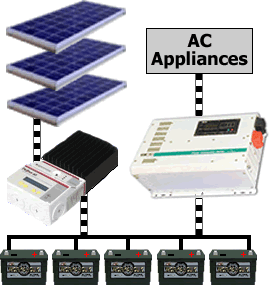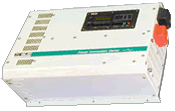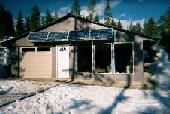|
 |
A Solar Energy System is sometimes referred to as an Alternative Energy System. And while that's true, wind, geothermal, and hydro systems are also alternative energy sources. We focus primarily on Solar and will therefore simply use the phrase Solar Energy System or Solar Power System. To the left are the basic components required to produce electricity from the sun. You will need one or more Solar Panels, a Charger Controller, a Power Inverter, and of course, Batteries. A brief explanation on each follows. After you get an idea of the components you'll need for your solar energy system, be sure to check out our new interactive Design Tools to calculate how many solar panels and storage batteries you will need, determine battery bank wiring, and calculate proper wire sizes. |
|
|
 |
|
The first component needed is one or more Solar Panels. They supply the electricity and charge the batteries. A very small system could get away with a couple 80 watt panels but figure at least 4 to 8 for a small to medium system. I am currently using only 6 panels to completely power this Solar Home. |
 |
|
|
 |
|
A Charge Controller. is needed to prevent overcharging of the batteries. Proper charging will prevent damage and increase the life and performance of the batteries. |
|
|
The Power Inverter is the heart of the system. It makes 120 volts AC from the 12 volts DC stored in the batteries. It can also charge the batteries if connected to a generator or the AC line. |
 |
|
|
 |
|
Last are the storage Batteries. They store the electrical power in the form of a chemical reaction. Without storage you would only have power when the sun was shining or the generator was running. |
|
|
|
| Summary |
|---|
| To summarize, there are four basic components: the Solar Panels, a Charge Controller, a Power Inverter, and the Storage Batteries. You will of course need the proper wires & cables to connect everything and a meter to keep an eye on things would be nice. Depending on system size, costs vary widely from as little as $1,500 to $50,000 or more. Much more information is available in the remaining tutorials. For more detailed information also view the Advanced Tutorial section. And don't miss our new interactive Design Tools. |
|
|
 |
This small energy efficient home uses six 80 watt solar panels, a Trace 60 amp charge controller, a Trace 2500 watt true sine wave inverter and fifteen 105 AmpHour batteries. Click on the image for details and new updated pictures of Solar array. (Trace is now Xantrex)
|
|
|
|
|
|
|


